

Livestock falling ill in fracking regions, raising concerns about food - News. Marginal Areas can Drive Farm Profitability. Wasps v moths: Biocontrol uses nature against crop pests. 21 January 2013Last updated at 21:51 ET By Katia Moskvitch Technology reporter, BBC News.
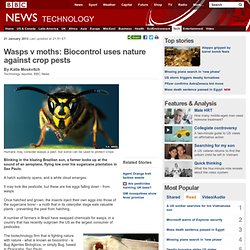
Ash dieback unstoppable, but fungicides could save most valuable. Wildflowers at risk from 'safe' levels of pollution. A paper just published in Proceedings of the National Academy of Sciences shows the impacts of nitrogen deposition in the environment may extend even further than previously thought.
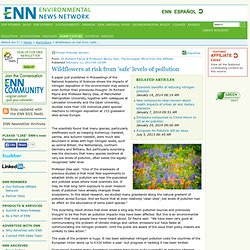
Dr Richard Payne and Professor Nancy Dise, of Manchester Metropolitan University, together with colleagues at Lancaster University and the Open University, studied more than 100 individual plant species' reactions to nitrogen deposition at 153 grassland sites across Europe. Plant oils may provide a pathway to health and sustainability. In a new article, published in this month’s Plant Biotechnology Journal, scientists at Rothamsted Research describe their innovative research to unlock plant lipid pathways, to produce oils with greater nutritional potential as well as helping to address issues of fish stock sustainability.

The article forms part of the most comprehensive and authoritative reviews on plant metabolic engineering to date and describes some of the achievements to date, as well as the research bottlenecks and future direction. It also highlights how plant lipid metabolism is significantly more complicated than previously imagined. Lead author Dr Richard Haslam said "This approach may lead to crops with novel traits, including seed oils with greater nutritional potential". Mask Africa Renewable Energy Food Security News Mask Africa Mask-Africa: Food Security. An increase in the amount of land being used for crops is one of the main reasons for the continuing loss of biodiversity and threatens to undermine attempts to meet international environmental goals, according to a new report backed by the United Nations Environment Programme (UNEP).

The report, entitled Crop Expansion and Conservation Priorities in Tropical Countries, details how land, which is often rich in biodiversity, is being converted or set aside for crops like rice and maize in some 128 tropical countries. The study warns that such trends, if continued, could derail progress towards meeting the Aichi Biodiversity Targets – a set of 20, time-bound measurable targets aimed at halting global biodiversity loss by the middle of the century. They found that cropland in tropical countries expanded by around 48,000 km² per year from 1999-2008. Rice was the single crop grown over the largest area, especially in tropical forest habitats. Desertification solution? Olive Trees. The planting of ten of thousands of olive trees in arid areas in Israel have proved highly beneficial, according to a study which said the trees provide shade for animals, purge the air and even produce excellent olive oil.

The study was conducted by the Faculty of Agriculture at the Hebrew University in Jerusalem, with the help of the Agricultural Research Organization. Dr. Desert bacteria could help boost crop yields. Desert soil microbes could help halt desertification and boost agriculture in arid regions of the Middle East and North Africa, according to a study.
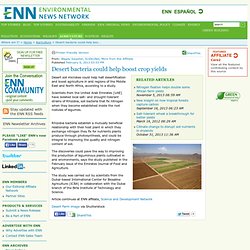
Scientists from the United Arab Emirates [UAE] have isolated local salt- and drought-tolerant strains of Rhizobia, soil bacteria that fix nitrogen when they become established inside the root nodules of legumes. Rhizobia bacteria establish a mutually beneficial relationship with their host plant in which they exchange nitrogen they fix for nutrients plants produce through photosynthesis, and could be integral to improving the quality and nitrogen content of soil. Study Suggests Plants Can Be Altruistic Too. Livestock falling ill in fracking regions, raising concerns about food. While scientists have yet to isolate cause and effect, many suspect chemicals used in drilling and hydrofracking (or "fracking") operations are poisoning animals through the air, water, or soil.
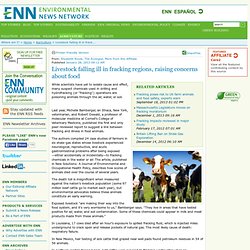
Last year, Michelle Bamberger, an Ithaca, New York, veterinarian, and Robert Oswald, a professor of molecular medicine at Cornell's College of Veterinary Medicine, published the first and only peer-reviewed report to suggest a link between fracking and illness in food animals. The authors compiled 24 case studies of farmers in six shale-gas states whose livestock experienced neurological, reproductive, and acute gastrointestinal problems after being exposed—either accidentally or incidentally—to fracking chemicals in the water or air. The article, published in New Solutions: A Journal of Environmental and Occupational Health Policy, describes how scores of animals died over the course of several years. Continue reading at The Ecologist. Livestock image via Shutterstock. 275na3.pdf (application/pdf Object) Climate tax on meat and milk results in less greenhouse gases. A climate tax corresponding to €60/ton CO2eq (equivalent carbon dioxide) on meat and milk could reduce greenhouse gas emissions from European agriculture by around seven per cent.
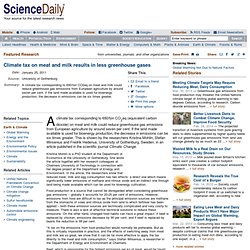
If the land made available is used for bioenergy production, the decrease in emissions can be six times greater. This is shown by the researchers Kristina Mohlin, Stefan Wirsenius and Fredrik Hedenus, University of Gothenburg, Sweden, in an article published in the scientific journal Climatic Change. Kristina Mohlin is a PhD student at the Department of Economics at the University of Gothenburg. She wrote the article together with her research colleagues at Chalmers University of Technology in connection with her degree project at the Department of Energy and Environment.
Food production is a source that cannot be disregarded when considering greenhouse gas emissions -- globally it accounts for 20-25 per cent of emissions. "A tax on the emissions from food production would normally be preferable. In beef production, cow-calf phase contributes most greenhouse gases. Scientists have long known that cattle produce carbon dioxide and methane throughout their lives, but a new study pinpoints the cow-calf stage as a major contributor of greenhouse gases during beef production.
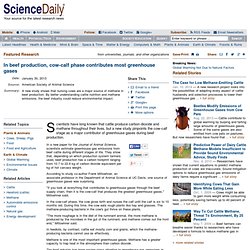
In a new paper for the Journal of Animal Science, scientists estimate greenhouse gas emissions from beef cattle during different stages of life. They show that, depending on which production system farmers used, beef production has a carbon footprint ranging from 10.7 to 22.6 kg of carbon dioxide equivalent per kg of hot carcass weight. According to study co-author Frank Mitloehner, an associate professor in the Department of Animal Science at UC Davis, one source of greenhouse gases was surprising. Anatomy gave some grasses the upper hand. BROWN (US) — Anatomy explains why some grasses evolved a more efficient means of photosynthesis than others, scientists report.

2020 vision: tackling future arable challenges - 12/29. Livestock livelihoods for the poor: Beyond milk, meat and eggs. Kenya farm boy drinking milk (photo credit: ILRI/Dave Elsworth). The science journal Animal Frontiers this month (Jan 2013) focuses on the links between livestock production and food security. Maggie Gill edited the issue.
Gill is an animal nutritionist by training who has spent years as a senior member of research institutions in the the UK (Natural Resources Institute, Natural Resources International, Macaulay Land Use Research Institute, Scottish Government) and presently divides her time between work for the UK Department for International Development and the University of Aberdeen while also serving on the CGIAR’s Independent Science and Partnership Council. She is a former board member of the International Livestock Research Institute (ILRI). Bad weather prompting more British farmers to consider GM use. Global irrigated area at record levels according to research. In 2009, the most recent year for which global data are available from the United Nations Food and Agriculture Organization (FAO), 311 million hectares in the world was equipped for irrigation but only 84 percent of that area was actually being irrigated, according to new research conducted by the Worldwatch Institute.
As of 2010, the countries with the largest irrigated areas were India (39 million hectares), China (19 million), and the United States (17 million), writes report author Judith Renner. Irrigation can offer crop yields that are two to four times greater than is possible with rainfed farming, and it currently provides 40 percent of the world's food from approximately 20 percent of all agricultural land. Irrigation efficiency makes jump with iFarm app. NMSU civil engineering Professor Zohrab Samani and local farmer John Storm view data on iFarm, an online application developed by Samani to enable more efficient water usage on farms.
Mask Africa Renewable Energy Food Security News Mask Africa Mask-Africa: Food Security. High immunity cows soon available. Sires with a higher natural level of disease resistance will soon be available for farmers to buy, thanks to the latest technology.